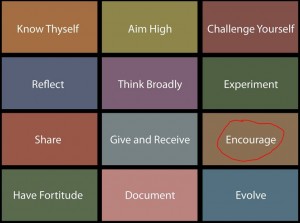I know you thought I forgot or got bored with this series of essays, or something. I didn’t. I just had a lot of other stuff to do and a lot of other things about which to write.
This is part of an ongoing series of essays responding to Weeks Ringle’s post called QuiltCon Homework. Read my last essay at discussing the concept of “giving and receiving.”

In her blog post, Weeks writes “Encourage one another. Bill and I have an agreement: love it for 10 minutes, which means that before you decide if you like it or not, give it 10 minutes. Look carefully. Think about it. Listen to the point of view and find at least as many positive things to say as negative ones.”
The bottomline is that it is not going to kill you to encourage someone else in their quiltmaking process. It is easy to be nasty about someone’s work, especially if they are a beginner and don’t have a clue. It is easy to disparage someone’s work because you don’t like the fabrics, there is cat hair on the quilt or you are in a bad mood. Everyone is striving to do something great and YOU, by a kind word or comment, can encourage them.
I am terrible at math. I can do addition and subtraction and most multiplication. I have a calculator for big number multiplication and long division. I sort of know what ratios are good for. I always need to ask my DH about certain formulas I use at work just to make sure I still understand that cryptic note I hid under my monitor. That thing called calculus is really just a myth in Jaye-world, like a griffin (unicorns are real, BTW, you just haven’t seen one. 😉 ) Math really makes no sense to me. Really.
I get along fine without it, mostly, but I am not scared of it.
I worked really hard at math in the 4th grade to , because of Mrs. Gellman. I did 3rd and 4th grade in the same year, so I came to Mrs. Gellman’s classroom after Christmas. I was small and scared and didn’t know anyone and I had missed half a year of work. The friends I had were all back in Mrs. Saraceno’s 3rd grade classroom. Mrs. Gellman was not a warm fuzzy teacher. I remember that she had grey hair and could be described as buxom. She wore calico housedress-type dresses and black orthopedic shoes.
Mrs. Gellman, however, was inspired. She had the best art projects. Her classroom was always mobbed during open house. People who had been in her class years before would come back to see what her class had done that year.
We made a city. Each person had to bring in a variety of boxes that would become the buildings. My dad gave me some clear plastic tubes with red ends and the class made a monorail (interurban train) system out of them. Mrs. Gellman was VERY pleased with me.
In the fourth grade, here in California, everyone does some kind of Mission project. In Mrs. Gellman’s class, we all worked together and made one mission. I am not sure if the design was from one of the real missions or if it was our interpretation of one of the missions. We made real bricks our of clay (I think the hay in adobe was a problem) and built them up into the mission and its outbuildings.
We made Japanese kites. Mine was a large pink box kite.
The key to the art projects was that you had to finish your other work first. Once that formality was out of the way then you could go over and work on the art project. English, history and all the liberal arts subjects were a snap for me, but math forced me to sit at that &^%$#@ math table struggling with my multiplication tables or with 20 long division problems. I did them for the art, but I also did them, because Mrs. Gellman didn’t leave me there alone to struggle. She would come by and give me a tip or a little help and always, ALWAYS tell me she knew I could do them. She encouraged me and her encouragement kept me working.
She knew how to teach and even in the 4th grade I knew it. Now I have coping skills for math (DH, Excel and a calculator), but I am not scared to do math. I know my limits, I know what I calculate will probably be wrong and I know how to cope. I hear Mrs. Gellman in my mind telling me that I can do it, so I continue to try. A few kind words have stuck with me all these years.
I promise you that nobody will die when you encourage someone else in their quiltmaking process. Nothing will be taken away from you or your quilts. You might learn something by having to look for the smallest thing with which to encourage someone. AND you might be the subject of a blog post when someone writes about how they were encouraged at the beginning of their quiltmaking journey.
Image courtesy of The Modern Quilt Studio